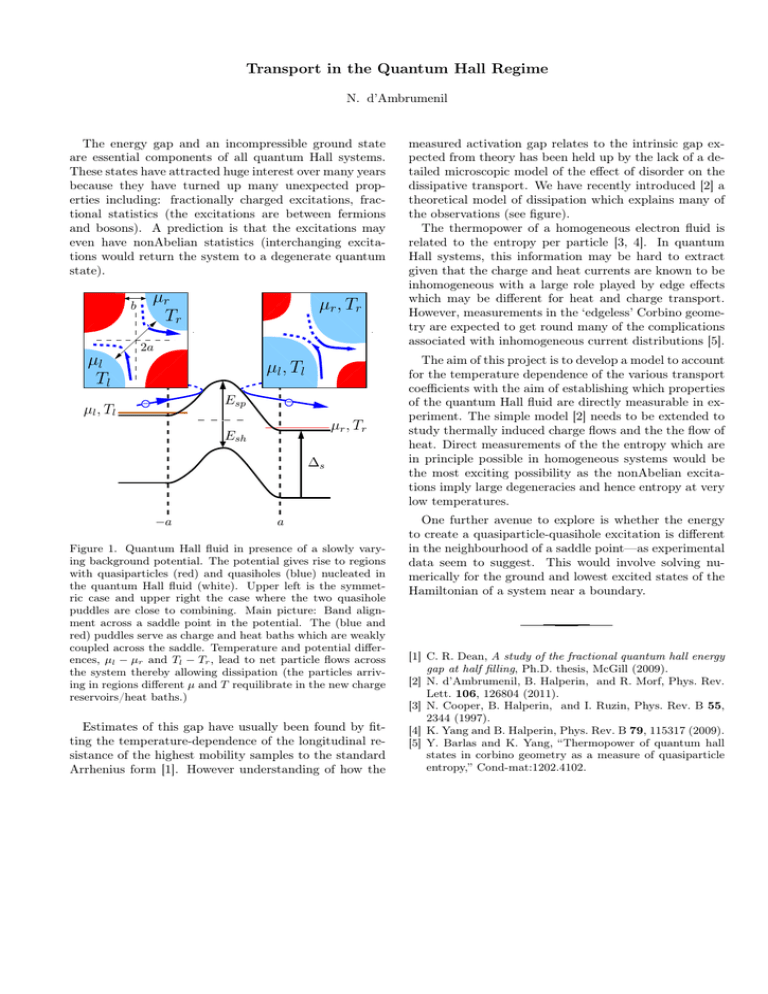Transport in the Quantum Hall Regime
advertisement

Transport in the Quantum Hall Regime N. d’Ambrumenil The energy gap and an incompressible ground state are essential components of all quantum Hall systems. These states have attracted huge interest over many years because they have turned up many unexpected properties including: fractionally charged excitations, fractional statistics (the excitations are between fermions and bosons). A prediction is that the excitations may even have nonAbelian statistics (interchanging excitations would return the system to a degenerate quantum state). µr Tr b µr , Tr 2a µl Tl µl , Tl µl , Tl Esp − − µr , Tr Esh ∆s −a a Figure 1. Quantum Hall fluid in presence of a slowly varying background potential. The potential gives rise to regions with quasiparticles (red) and quasiholes (blue) nucleated in the quantum Hall fluid (white). Upper left is the symmetric case and upper right the case where the two quasihole puddles are close to combining. Main picture: Band alignment across a saddle point in the potential. The (blue and red) puddles serve as charge and heat baths which are weakly coupled across the saddle. Temperature and potential differences, µl − µr and Tl − Tr , lead to net particle flows across the system thereby allowing dissipation (the particles arriving in regions different µ and T requilibrate in the new charge reservoirs/heat baths.) Estimates of this gap have usually been found by fitting the temperature-dependence of the longitudinal resistance of the highest mobility samples to the standard Arrhenius form [1]. However understanding of how the measured activation gap relates to the intrinsic gap expected from theory has been held up by the lack of a detailed microscopic model of the effect of disorder on the dissipative transport. We have recently introduced [2] a theoretical model of dissipation which explains many of the observations (see figure). The thermopower of a homogeneous electron fluid is related to the entropy per particle [3, 4]. In quantum Hall systems, this information may be hard to extract given that the charge and heat currents are known to be inhomogeneous with a large role played by edge effects which may be different for heat and charge transport. However, measurements in the ‘edgeless’ Corbino geometry are expected to get round many of the complications associated with inhomogeneous current distributions [5]. The aim of this project is to develop a model to account for the temperature dependence of the various transport coefficients with the aim of establishing which properties of the quantum Hall fluid are directly measurable in experiment. The simple model [2] needs to be extended to study thermally induced charge flows and the the flow of heat. Direct measurements of the the entropy which are in principle possible in homogeneous systems would be the most exciting possibility as the nonAbelian excitations imply large degeneracies and hence entropy at very low temperatures. One further avenue to explore is whether the energy to create a quasiparticle-quasihole excitation is different in the neighbourhood of a saddle point—as experimental data seem to suggest. This would involve solving numerically for the ground and lowest excited states of the Hamiltonian of a system near a boundary. [1] C. R. Dean, A study of the fractional quantum hall energy gap at half filling, Ph.D. thesis, McGill (2009). [2] N. d’Ambrumenil, B. Halperin, and R. Morf, Phys. Rev. Lett. 106, 126804 (2011). [3] N. Cooper, B. Halperin, and I. Ruzin, Phys. Rev. B 55, 2344 (1997). [4] K. Yang and B. Halperin, Phys. Rev. B 79, 115317 (2009). [5] Y. Barlas and K. Yang, “Thermopower of quantum hall states in corbino geometry as a measure of quasiparticle entropy,” Cond-mat:1202.4102.






